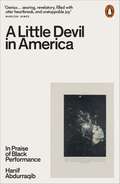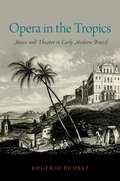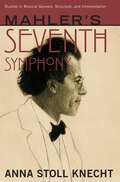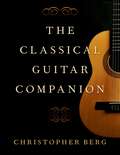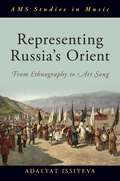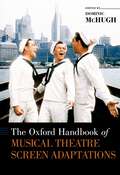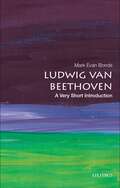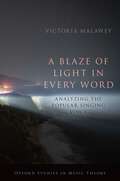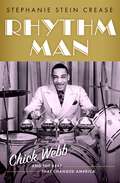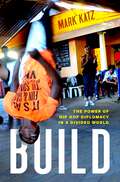- Table View
- List View
A Little Devil in America: In Praise of Black Performance
by Hanif AbdurraqibAn electrifying celebration of Black performances, cultures and communities in the United States, from the New York Times bestselling poet and critic Hanif Abdurraqib'Gorgeous' - Brit Bennett'Pure genius' - Jacqueline Woodson'One of the most dynamic books I have ever read' - Clint SmithAt the March on Washington, Josephine Baker reflected on her life and her legacy. She had spent decades as one of the most successful entertainers in the world, but, she told the crowd, "I was a devil in other countries, and I was a little devil in America, too". Inspired by these words, Hanif Abdurraqib has written a stirring meditation on Black performance in the modern age, in which culture, history and his own lived experience collide.With sharp insight, humour and heart, Abdurraqib explores a sequence of iconic and intimate performances that take him from mid-century Paris to the moon -- and back down again, to a cramped living room in Columbus, Ohio. Each one, he shows, has layers of resonance across Black and white cultures, the politics of American empire, and his own personal history of love and grief -- whether it's the twenty-seven seconds of 'Gimme Shelter' in which Merry Clayton sings, or the magnificent hours of Aretha Franklin's homegoing; Beyoncé's Super Bowl show or a schoolyard fistfight; Dave Chapelle's skits or a game of spades among friends.
The Lyrics: 1956 to the Present
by Paul McCartneyThe Sunday Times bestseller and Waterstones Book of the Year, now in paperback‘Paul McCartney says this is as close as he will get to an autobiography and no wonder – his life is in every line of these songs ... pure joy’ Sunday Times, Book of the Year With seven songs added for this edition: ‘Bluebird,’ ‘Day Tripper,’ ‘English Tea,’ ‘Every Night,’ ‘Hello, Goodbye,’ ‘Magical Mystery Tour’ and ‘Step Inside Love’Spanning seven decades – from his early Liverpool days, through the historic decade of The Beatles, to Wings and his long solo career – Paul McCartney’s The Lyrics has transformed the way artists write about music, pairing the definitive texts of 161 songs with intimate, autobiographical commentaries on McCartney’s life and music.Arranged alphabetically, these commentaries reveal the diverse circumstances in which the songs were written, how they ultimately came to be, and the remarkable – often ordinary – people and places that inspired them. Dozens of vignettes re-create the working-class Liverpool of McCartney’s youth, where delivery boys ran parcels on docks, as in ‘On My Way to Work,’ and elderly ladies in the neighbourhood inspired ‘Eleanor Rigby.’ McCartney also introduces us to his early literary influences, among them Shakespeare, Lewis Carroll and Allen Ginsberg, as well as Alan Durband, his beloved English teacher, and his mother, Mary, who passed away when he was just fourteen – and whose memory has infused his work ever since.Yet the two most powerful presences in The Lyrics after the author himself are his songwriting partner, John Lennon, and his ‘Golden Earth Girl,’ Linda Eastman McCartney. Here McCartney describes how he met John at a church fête in 1957; their adventures with George Harrison and Ringo Starr in the early 1960s; and how, at the end of the decade, they, and The Beatles, broke up. Thus began a second act of now more than fifty years, with Linda and family life as driving forces – inspiring songs from ‘Maybe I’m Amazed,’ written just after the breakup of The Beatles, to the 2012 ballad ‘My Valentine,’ addressed to McCartney’s wife and partner, Nancy Shevell McCartney.Edited and introduced by Pulitzer Prize–winning poet Paul Muldoon, and enhanced by more than a hundred images from McCartney’s personal archives – including handwritten texts, mementos, and photographs – and seven new song commentaries, The Lyrics is a book for the ages, and the definitive literary and visual record of one of the greatest songwriters of all time.
Opera in the Tropics: Music and Theater in Early Modern Brazil (Currents in Latin American and Iberian Music)
by Rogério BudaszOpera in the Tropics is an engaging exploration of theater with music in Brazil from the mid 1500s to the early 1820s. Author Rogério Budasz delves into the practices of the actors, singers, poets, and composers who created and performed Jesuit moral plays, Spanish comedias, and Portuguese vernacular operas and entremezes during the colonial period, as well as the Italian operas that celebrated the new independent nation in 1822. A Brazilian producer claimed in 1825 that the goal of music-theater was to instruct, entertain, and distract the population. Budasz argues that this threefold goal had in fact been present throughout the colonial period, in different combinations and with different purposes, at the hands of missionaries, intellectuals, bureaucrats, political leaders, and cultural producers. While Budasz demonstrates a continuity from Portuguese theatrical practices, primarily through the circulation of artists and repertory, he also examines a number of localized departures from the metropolitan model, particularly in the ethnic and gender profile of theatrical workers, in the modifications determined by local tastes, priorities, and materials, and in the political use of theater as an ideological and civilizing tool within the paradoxical context of a slave society. An eye-opening narrative of the transformations and uses of a colonial art form, Opera in the Tropics will be essential reading for all interested in the music and theater in Iberian and Latin American culture.
MAHLER'S SEVENTH SYMPHONY SMGS C (Studies in Musical Genesis, Structure, and Interpretation)
by Anna Stoll KnechtGustav Mahler's Seventh Symphony stands out as one of the most provocative symphonic statements of the early twentieth century. Throughout its performance history, it has often been heard as "existing in the shadow" of the Sixth Symphony or as "too reminiscent" of Richard Wagner's opera Die Meistersinger von Nürnberg. Anna Stoll Knecht's Mahler's Seventh Symphony offers a new interpretation of the Seventh based on a detailed study of Mahler's compositional materials and a close reading of the finished work. With a focus on sketches previously considered as "discarded," Stoll Knecht exposes unexpected connections between the Seventh and both the Sixth and Meistersinger, confirming that Mahler's compositional project was firmly grounded in a dialogue with works from the past. This referential aspect acts as an important interpretive key to the work, enabling the first thorough analysis of the sketches and drafts for the Seventh, and shedding light on its complex compositional history. Considering each movement of the symphony through a double perspective, genetic and analytic, Stoll Knecht demonstrates how sketch studies and analytical approaches can interact with each other. Mahler's Seventh Symphony exposes new facets of Mahler's musical humor and leads us to rethink much-debated issues concerning the composer's cultural identity, revealing the Seventh's pivotal role within his output.
The Classical Guitar Companion
by Christopher BergThe Classical Guitar Companion is an anthology of guitar exercises, etudes, and pieces organized according to technique or musical texture. Expert author Christopher Berg, a veteran guitar instructor, bring together perspectives as an active performing artist and as a teacher who has trained hundreds of guitarists to encourages students to work based on their own strengths and weaknesses. The book opens with "Learning the Fingerboard", a large section devoted to establishing a thorough knowledge of the guitar fingerboard through a systematic and rigorous study of scales and fingerboard harmony, which will lead to ease and fluency in sight-reading and will reduce the time needed to learn a repertoire piece. The following sections "Scales and Scale Studies", "Repeated Notes", "Slurs", "Harmony", "Arpeggios", "Melody with Accompaniment", "Counterpoint" and "Florid or Virtuoso Studies" each contain text and examples that connect material to fingering practices of composers and practice strategies to open a path to interpretive freedom in performance. The Classical Guitar Companion will serve as a helpful companion for many years of guitar study.
The Classical Guitar Companion
by Christopher BergThe Classical Guitar Companion is an anthology of guitar exercises, etudes, and pieces organized according to technique or musical texture. Expert author Christopher Berg, a veteran guitar instructor, bring together perspectives as an active performing artist and as a teacher who has trained hundreds of guitarists to encourages students to work based on their own strengths and weaknesses. The book opens with "Learning the Fingerboard", a large section devoted to establishing a thorough knowledge of the guitar fingerboard through a systematic and rigorous study of scales and fingerboard harmony, which will lead to ease and fluency in sight-reading and will reduce the time needed to learn a repertoire piece. The following sections "Scales and Scale Studies", "Repeated Notes", "Slurs", "Harmony", "Arpeggios", "Melody with Accompaniment", "Counterpoint" and "Florid or Virtuoso Studies" each contain text and examples that connect material to fingering practices of composers and practice strategies to open a path to interpretive freedom in performance. The Classical Guitar Companion will serve as a helpful companion for many years of guitar study.
Pal Joey: The History of a Heel (Broadway Legacies)
by Julianne LindbergWhen Rodgers and Hart's Pal Joey opened at the Barrymore on Christmas day, 1940, it flew in the face of musical comedy convention. The characters and situation were depraved. The setting was caustically realistic. Its female lead was frankly sexual and yet not purely comic. A narratively-driven dream ballet closed the first act, begging audiences to take seriously the inner life and desires of a confirmed heel. Pal Joey: The History of a Heel presents a behind-the-scenes look at the genesis, influence, and significance of this classic musical comedy. Although the show appears on many top-ten lists surveying the Golden Age, it is a controversial classic; its legacy is tied both to the fashionable scandal that it provoked, and, retrospectively, to the uncommon attention it paid to characterization and narrative cohesion. Through an archive-driven investigation of the show and its music, author Julianne Lindberg offers insight into the historical moment during which Joey was born, and to the process of genre classification, canon formation, and the ensuing critical debates related to musical and theatrical maturity. More broadly, the book argues that the critique and commentary on class and gender conventions in Pal Joey reveals a uniquely American concern over status, class mobility, and progressive gender roles in the pre-war era.
Pal Joey: The History of a Heel (Broadway Legacies)
by Julianne LindbergWhen Rodgers and Hart's Pal Joey opened at the Barrymore on Christmas day, 1940, it flew in the face of musical comedy convention. The characters and situation were depraved. The setting was caustically realistic. Its female lead was frankly sexual and yet not purely comic. A narratively-driven dream ballet closed the first act, begging audiences to take seriously the inner life and desires of a confirmed heel. Pal Joey: The History of a Heel presents a behind-the-scenes look at the genesis, influence, and significance of this classic musical comedy. Although the show appears on many top-ten lists surveying the Golden Age, it is a controversial classic; its legacy is tied both to the fashionable scandal that it provoked, and, retrospectively, to the uncommon attention it paid to characterization and narrative cohesion. Through an archive-driven investigation of the show and its music, author Julianne Lindberg offers insight into the historical moment during which Joey was born, and to the process of genre classification, canon formation, and the ensuing critical debates related to musical and theatrical maturity. More broadly, the book argues that the critique and commentary on class and gender conventions in Pal Joey reveals a uniquely American concern over status, class mobility, and progressive gender roles in the pre-war era.
Representing Russia's Orient: From Ethnography to Art Song (AMS Studies in Music)
by Adalyat IssiyevaThroughout history, Russia's geo-political and cultural position between the East and West has shaped its national identity. Representing Russia's Orient tells the story of how Russia's imperial expansion and encounters with its Asian neighbors influenced the formation and development of Russian musical identity in the long nineteenth century. While Russia's ethnic minorities, or inorodtsy, were located at the geographical and cultural periphery, they loomed large in composers' perception and musical imagination and became central to the definition of Russianness itself. Drawing from a long-forgotten archive of Russian musical examples, visual art, and ethnographies, author Adalyat Issiyeva offers an in-depth study of Russian art music's engagement with oriental subjects. Within a complex matrix of politics, competing ideological currents, and social and cultural transformations, some Russian composers and writers developed multidimensional representations of oriental "others" and sometimes even embraced elements of Asian musical identity. In three detailed case studies--on the leader of the Mighty Five, Milii Balakirev, Decembrist sympathizer Alexander Aliab'ev, and the composers affiliated with the Music-Ethnography Committee--Issiyeva traces how and why these composers adopted "foreign" musical elements. In this way, she provides a fresh look at how Russians absorbed and transformed elements of Asian history and culture in forging a national identity for themselves.
Representing Russia's Orient: From Ethnography to Art Song (AMS Studies in Music)
by Adalyat IssiyevaThroughout history, Russia's geo-political and cultural position between the East and West has shaped its national identity. Representing Russia's Orient tells the story of how Russia's imperial expansion and encounters with its Asian neighbors influenced the formation and development of Russian musical identity in the long nineteenth century. While Russia's ethnic minorities, or inorodtsy, were located at the geographical and cultural periphery, they loomed large in composers' perception and musical imagination and became central to the definition of Russianness itself. Drawing from a long-forgotten archive of Russian musical examples, visual art, and ethnographies, author Adalyat Issiyeva offers an in-depth study of Russian art music's engagement with oriental subjects. Within a complex matrix of politics, competing ideological currents, and social and cultural transformations, some Russian composers and writers developed multidimensional representations of oriental "others" and sometimes even embraced elements of Asian musical identity. In three detailed case studies--on the leader of the Mighty Five, Milii Balakirev, Decembrist sympathizer Alexander Aliab'ev, and the composers affiliated with the Music-Ethnography Committee--Issiyeva traces how and why these composers adopted "foreign" musical elements. In this way, she provides a fresh look at how Russians absorbed and transformed elements of Asian history and culture in forging a national identity for themselves.
The Oxford Handbook of Musical Theatre Screen Adaptations (Oxford Handbooks)
by Dominic McHughHollywood's conversion to sound in the 1920s created an early peak in the film musical, following the immense success of The Jazz Singer. The opportunity to synchronize moving pictures with a soundtrack suited the musical in particular, since the heightened experience of song and dance drew attention to the novelty of the technological development. Until the near-collapse of the genre in the 1960s, the film musical enjoyed around thirty years of development, as landmarks such as The Wizard of Oz, Meet Me in St Louis, Singin' in the Rain, and Gigi showed the exciting possibilities of putting musicals on the silver screen. The Oxford Handbook of Musical Theatre Screen Adaptations traces how the genre of the stage-to-screen musical has evolved, starting with screen adaptations of operettas such as The Desert Song and Rio Rita, and looks at how the Hollywood studios in the 1930s exploited the publication of sheet music as part of their income. Numerous chapters examine specific screen adaptations in depth, including not only favorites such as Annie and Kiss Me, Kate but also some of the lesser-known titles like Li'l Abner and Roberta and problematic adaptations such as Carousel and Paint Your Wagon. Together, the chapters incite lively debates about the process of adapting Broadway for the big screen and provide models for future studies.
Ludwig van Beethoven: A Very Short Introduction (Very Short Introductions)
by Mark Evan BondsProposes a new way of listening to Beethoven by understanding his music as an expression of his entire self, not just the iconic scowl Despite the ups and downs of his personal life and professional career - even in the face of deafness - Beethoven remained remarkably consistent in his most basic convictions about his art. This inner consistency, writes the music historian Mark Evan Bonds, provides the key to understanding the composer's life and works. Beethoven approached music as he approached life, weighing whatever occupied him from a variety of perspectives: a melodic idea, a musical genre, a word or phrase, a friend, a lover, a patron, money, politics, religion. His ability to unlock so many possibilities from each helps explain the emotional breadth and richness of his output as a whole, from the heaven-storming Ninth Symphony to the eccentric Eighth, and from the arcane Great Fugue to the crowd-pleasing Wellington's Victory. Beethoven's works, Bonds argues, are a series of variations on his life. The iconic scowl so familiar from later images of the composer is but one of many attitudes he could assume and project through his music. The supposedly characteristic furrowed brow and frown, moreover, came only after his time. Discarding tired myths about the composer, Bonds proposes a new way of listening to Beethoven by hearing his music as an expression of his entire self, not just his scowling self.
Ludwig van Beethoven: A Very Short Introduction (Very Short Introductions)
by Mark Evan BondsProposes a new way of listening to Beethoven by understanding his music as an expression of his entire self, not just the iconic scowl Despite the ups and downs of his personal life and professional career - even in the face of deafness - Beethoven remained remarkably consistent in his most basic convictions about his art. This inner consistency, writes the music historian Mark Evan Bonds, provides the key to understanding the composer's life and works. Beethoven approached music as he approached life, weighing whatever occupied him from a variety of perspectives: a melodic idea, a musical genre, a word or phrase, a friend, a lover, a patron, money, politics, religion. His ability to unlock so many possibilities from each helps explain the emotional breadth and richness of his output as a whole, from the heaven-storming Ninth Symphony to the eccentric Eighth, and from the arcane Great Fugue to the crowd-pleasing Wellington's Victory. Beethoven's works, Bonds argues, are a series of variations on his life. The iconic scowl so familiar from later images of the composer is but one of many attitudes he could assume and project through his music. The supposedly characteristic furrowed brow and frown, moreover, came only after his time. Discarding tired myths about the composer, Bonds proposes a new way of listening to Beethoven by hearing his music as an expression of his entire self, not just his scowling self.
A Blaze of Light in Every Word: Analyzing the Popular Singing Voice (Oxford Studies in Music Theory)
by Victoria MalaweyThe human singing voice holds immense power - to convey mood, emotion, and identity in songs, provide music's undeniable "wow" moments, and communicate a pop song's meaning perhaps more than any other musical parameter. And unlike the other aspects of musical content - like harmony, form, melody, and rhythm, for which generations of scholars have formed sophisticated analyses - scholarly approaches to vocal delivery remain grossly underdeveloped. An exciting and much-needed new approach, A Blaze of Light in Every Word presents a systematic and encompassing conceptual model for analyzing vocal delivery. Author Victoria Malawey focuses on three overlapping areas of inquiry - pitch, prosody, and quality - while drawing on research from music theory and pedagogy as well as gender studies and philosophy to situates the sonic and material aspects of vocal delivery among broader cultural, philosophical, and anthropological approaches to voice. Malawey develops a much-needed and innovative set of analytical tools through in-depth analyses of popular song recordings in genres spanning from hip hop to death metal. A Blaze of Light in Every Word brings new clarity to the relationship between the voice's sonic content and its greater signification, helping us understand the complexity and uniqueness of singing voices.
A Blaze of Light in Every Word: Analyzing the Popular Singing Voice (Oxford Studies in Music Theory)
by Victoria MalaweyThe human singing voice holds immense power - to convey mood, emotion, and identity in songs, provide music's undeniable "wow" moments, and communicate a pop song's meaning perhaps more than any other musical parameter. And unlike the other aspects of musical content - like harmony, form, melody, and rhythm, for which generations of scholars have formed sophisticated analyses - scholarly approaches to vocal delivery remain grossly underdeveloped. An exciting and much-needed new approach, A Blaze of Light in Every Word presents a systematic and encompassing conceptual model for analyzing vocal delivery. Author Victoria Malawey focuses on three overlapping areas of inquiry - pitch, prosody, and quality - while drawing on research from music theory and pedagogy as well as gender studies and philosophy to situates the sonic and material aspects of vocal delivery among broader cultural, philosophical, and anthropological approaches to voice. Malawey develops a much-needed and innovative set of analytical tools through in-depth analyses of popular song recordings in genres spanning from hip hop to death metal. A Blaze of Light in Every Word brings new clarity to the relationship between the voice's sonic content and its greater signification, helping us understand the complexity and uniqueness of singing voices.
Schoenberg's Correspondence With Alma Mahler (Schoenberg in Words)
by Elizabeth Keathley Marilyn McCoyA fresh perspective on two well-known personalities, Schoenberg's Correspondence with Alma Mahler documents a modern music friendship beginning in fin-de-siécle Vienna and ending in 1950s Los Angeles. This volume is the first English-language edition of the complete extant correspondence in new English translations from the original German, many from new transcriptions of handwritten originals, and it is the first English-language book of Schoenberg's correspondence with a female associate. These often quite candid letters afford readers a fascinating glimpse into the personalities, ideologies, institutions, protocols, and aesthetics of early twentieth-century European music culture. Critics, conductors, composers, and visual artists are appraised, kindly or venomously; visual artists and writers also appear. Above all, Alma Mahler (1879-1964) and Arnold Schoenberg (1874-1951) emerge as intriguing, complex individuals who transcend their conventional representations as, respectively, a femme fatale and a musical radical. For Schoenberg, Alma was a sympathetic confidante, a comrade in their shared battle against musical conservatism, yet also a canny negotiator of Vienna's social circles, a skill that brought Schoenberg into contact with important patrons. Not only did he invite Alma to his premieres, lectures, and art exhibitions, but Schoenberg also sent her scores of his music and drafts of his writings. He revealed to her his plans for his innovative new music society, the Society for Private Music Performances, and his development of a new method of composition with twelve tones. The letters remind us of how crucial the social and personal dimensions of music culture were to the early twentieth-century composers and musicians. Gender, ethnicity, and social class conditioned their opportunities in music---and in life---and their shared experience of fleeing fascism to a new country with a different culture and language resonates with our own epoch.
Wendy Carlos: A Biography (Cultural Biographies)
by Amanda SewellWith her debut album Switched-On Bach, composer and electronic musician Wendy Carlos (b. 1939) brought the sound of the Moog synthesizer to a generation of listeners, helping to effect arguably one of the most substantial changes in popular music's sound since musicians began using amplifiers. Her story is not only one of a person who blazed new trails in electronic music for decades but is also the story of a person who intersected in many ways with American popular culture, medicine, and social trends during the second half of the 20th century and well into the 21st. There is much to tell about her life and about the ways in which her life reflects many dimensions of American culture. Carlos's identity as a transgender woman has shaped many aspects of her life, her career, how she relates to the public, and how the public has received her and her music. Cultural factors surrounding the treatment of transgender people affected many of the decisions that Carlos has made over the decades. Additionally, cultural reception and perception of transgender people has colored how journalists, scholars, and fans have written about Carlos and her music for decades.
Wendy Carlos: A Biography (Cultural Biographies)
by Amanda SewellWith her debut album Switched-On Bach, composer and electronic musician Wendy Carlos (b. 1939) brought the sound of the Moog synthesizer to a generation of listeners, helping to effect arguably one of the most substantial changes in popular music's sound since musicians began using amplifiers. Her story is not only one of a person who blazed new trails in electronic music for decades but is also the story of a person who intersected in many ways with American popular culture, medicine, and social trends during the second half of the 20th century and well into the 21st. There is much to tell about her life and about the ways in which her life reflects many dimensions of American culture. Carlos's identity as a transgender woman has shaped many aspects of her life, her career, how she relates to the public, and how the public has received her and her music. Cultural factors surrounding the treatment of transgender people affected many of the decisions that Carlos has made over the decades. Additionally, cultural reception and perception of transgender people has colored how journalists, scholars, and fans have written about Carlos and her music for decades.
Beethoven: Variations on a Life
by Mark Evan BondsDespite the ups and downs of his personal life and professional career-even in the face of deafness-Beethoven remained remarkably consistent in his most basic convictions about his art. This inner consistency, the music historian Mark Evan Bonds argues, provides the key to understanding the composer's life and works. Beethoven approached music as he approached life, weighing whatever occupied him from a variety of perspectives: a melodic idea, a musical genre, a word or phrase, a friend, a lover, a patron, money, politics, religion. His ability to unlock so many possibilities from each helps explain the emotional breadth and richness of his output as a whole, from the heaven-storming Ninth Symphony to the eccentric Eighth, and from the arcane Great Fugue to the crowd-pleasing Wellington's Victory. Beethoven's works, Bonds argues, are a series of variations on his life. The iconic scowl so familiar from later images of the composer is but one of many attitudes he could assume and project through his music. The supposedly characteristic furrowed brow and frown, moreover, came only after his time. Discarding tired myths about the composer, Bonds proposes a new way of listening to Beethoven by hearing his music as an expression of his entire self, not just his scowling self.
Beethoven: The Imperative Of Originality In The Symphony (Eastman Studies In Music Ser. #172)
by Mark Evan BondsDespite the ups and downs of his personal life and professional career-even in the face of deafness-Beethoven remained remarkably consistent in his most basic convictions about his art. This inner consistency, the music historian Mark Evan Bonds argues, provides the key to understanding the composer's life and works. Beethoven approached music as he approached life, weighing whatever occupied him from a variety of perspectives: a melodic idea, a musical genre, a word or phrase, a friend, a lover, a patron, money, politics, religion. His ability to unlock so many possibilities from each helps explain the emotional breadth and richness of his output as a whole, from the heaven-storming Ninth Symphony to the eccentric Eighth, and from the arcane Great Fugue to the crowd-pleasing Wellington's Victory. Beethoven's works, Bonds argues, are a series of variations on his life. The iconic scowl so familiar from later images of the composer is but one of many attitudes he could assume and project through his music. The supposedly characteristic furrowed brow and frown, moreover, came only after his time. Discarding tired myths about the composer, Bonds proposes a new way of listening to Beethoven by hearing his music as an expression of his entire self, not just his scowling self.
Using Technology with Elementary Music Approaches
by Amy M. BurnsDo you find it challenging to integrate technology into your elementary music classroom? Do you feel that it could enhance your classroom experience if you could implement it in an approachable and realistic way? In Using Technology with Elementary Music Approaches, author Amy M. Burns offers an all-in-one, classroom-vetted guide to integrate technology into the music classroom while keeping with core educational strategies. In this book, you will find practical lessons and ideas that can be used in any elementary classroom, whether that classroom has one device per educator or a device for every student. Written for a range of experience levels, lessons further enhance classrooms that utilize the approaches of Feierabend, Kodály, Orff Schulwerk, and project-based learning. Experts from each field-Dr. Missy Strong, Glennis Patterson, Ardith Collins, and Cherie Herring-offer a variety of approaches and project ideas in the project-based learning section. Complemented by a companion website of lesson videos, resource guides, and more, Using Technology with Elementary Music Approaches allows new and veteran educators to hit the ground running on the first day of school.
USING TECH ELEMENTARY MUSIC APPROACHES C
by Amy M. BurnsDo you find it challenging to integrate technology into your elementary music classroom? Do you feel that it could enhance your classroom experience if you could implement it in an approachable and realistic way? In Using Technology with Elementary Music Approaches, author Amy M. Burns offers an all-in-one, classroom-vetted guide to integrate technology into the music classroom while keeping with core educational strategies. In this book, you will find practical lessons and ideas that can be used in any elementary classroom, whether that classroom has one device per educator or a device for every student. Written for a range of experience levels, lessons further enhance classrooms that utilize the approaches of Feierabend, Kodály, Orff Schulwerk, and project-based learning. Experts from each field-Dr. Missy Strong, Glennis Patterson, Ardith Collins, and Cherie Herring-offer a variety of approaches and project ideas in the project-based learning section. Complemented by a companion website of lesson videos, resource guides, and more, Using Technology with Elementary Music Approaches allows new and veteran educators to hit the ground running on the first day of school.
Rhythm Man: Chick Webb and the Beat that Changed America (CULTURAL BIOGRAPHIES SERIES)
by Stephanie Stein CreaseThe first comprehensive biography of the Swing Era's pioneering virtuoso drummer and bandleader William Henry "Chick" Webb (1905-39) was one of the first virtuoso drummers in jazz and an innovative bandleader dubbed the "Savoy King," who reigned at Harlem's world-famous Savoy Ballroom. Along with the likes of Duke Ellington, Fletcher Henderson, and Cab Calloway, Webb helped create the popular dance and music culture, known as Swing, that swept the United States during and after the Great Depression and left an indelible impact on American culture. Having moved to Harlem from Baltimore during the Harlem Renaissance, Webb's creativity, charisma and persistence enabled him to navigate the harsh realities of racism and show business, lifting not only himself to stardom but also bringing other future legends-namely vocalist extraordinaire Ella Fitzgerald and R&B trailblazer Louis Jordan-along with him. But at the peak of his fame, at just 34 years of age, his life was cut short by the chronic spinal tuberculosis that had left him four feet tall with a hump on his back. In this first comprehensive biography of Webb, author Stephanie Stein Crease traces his story in full, showing how his skills and innovations as a bandleader helped catalyze the music of the Swing Era and the growing big band industry, allowing Webb to become one of the most influential musicians in jazz history. Crease explores Webb's personal and professional struggles as he rose to the top of the increasingly competitive world of big band jazz. Complete with rare photographs, posters, news clippings, and a discography, this biography will be a gift to jazz aficionados and scholars.
Rhythm Man: Chick Webb and the Beat that Changed America (CULTURAL BIOGRAPHIES SERIES)
by Stephanie Stein CreaseThe first comprehensive biography of the Swing Era's pioneering virtuoso drummer and bandleader William Henry "Chick" Webb (1905-39) was one of the first virtuoso drummers in jazz and an innovative bandleader dubbed the "Savoy King," who reigned at Harlem's world-famous Savoy Ballroom. Along with the likes of Duke Ellington, Fletcher Henderson, and Cab Calloway, Webb helped create the popular dance and music culture, known as Swing, that swept the United States during and after the Great Depression and left an indelible impact on American culture. Having moved to Harlem from Baltimore during the Harlem Renaissance, Webb's creativity, charisma and persistence enabled him to navigate the harsh realities of racism and show business, lifting not only himself to stardom but also bringing other future legends-namely vocalist extraordinaire Ella Fitzgerald and R&B trailblazer Louis Jordan-along with him. But at the peak of his fame, at just 34 years of age, his life was cut short by the chronic spinal tuberculosis that had left him four feet tall with a hump on his back. In this first comprehensive biography of Webb, author Stephanie Stein Crease traces his story in full, showing how his skills and innovations as a bandleader helped catalyze the music of the Swing Era and the growing big band industry, allowing Webb to become one of the most influential musicians in jazz history. Crease explores Webb's personal and professional struggles as he rose to the top of the increasingly competitive world of big band jazz. Complete with rare photographs, posters, news clippings, and a discography, this biography will be a gift to jazz aficionados and scholars.
Build: The Power of Hip Hop Diplomacy in a Divided World
by Mark KatzSince 2001, the U.S. Department of State has been sending hip hop artists abroad to perform and teach as goodwill ambassadors. There are good reasons for this: hip hop is known and loved across the globe, acknowledged and appreciated as a product of American culture. Hip hop has from its beginning been a means of creating community through artistic collaboration, fostering what hip hop artists call building. A timely study of U.S. diplomacy, Build: The Power of Hip Hop Diplomacy in a Divided World reveals the power of art to bridge cultural divides, facilitate understanding, and express and heal trauma. Yet power is never single-edged, and the story of hip hop diplomacy is deeply fraught. Drawing from nearly 150 interviews with hip hop artists, diplomats, and others in more than 30 countries, Build explores the inescapable tensions and ambiguities in the relationship between art and the state, revealing the ethical complexities that lurk behind what might seem mere goodwill tours. Author Mark Katz makes the case that hip hop, at its best, can promote positive, productive international relations between people and nations. A U.S.-born art form that has become a voice of struggle and celebration worldwide, hip hop has the power to build global community when it is so desperately needed. Cover image: Sylvester Shonhiwa, aka Bboy Sly, Harare, Zimbabwe, February 2015. Photograph by Paul Rockower.
